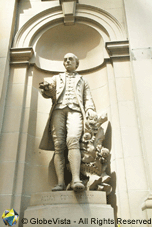Allan Cunningham statue

Public Art: Allan Cunningham statue
Sculptor: © Tommaso Sani
Description: The sandstone carving of Allan Cunningham, English botanist and explorer, is one of 23 sandstone carved figures on the ledges of the Lands Department Building. The balding botanist stands with his right hand clutching freshly cut plant specimens whilst his left-hand rests on a tree stump that is sprouting ferns and waratahs. He is wearing breeches and stockings.
Date Unveiled: c1891
Location: The Allan Cunningham statue is located on the Bent Street exterior niche of the Land Department Building, Bridge Street, Sydney, Australia.
So Who Was Allan Cunningham?
Allan Cunningham (13th July, 1791 – 27th June 1839) was an English botanist and explorer.
He was born in Wimbledon, Surrey, the son of Allan Cunningham who was the Head Gardener at Wimbledon Park House.
After graduating from school Cunningham worked for the superintendent of Kew gardens where he hobnobbed with the likes of Robert Brown and Sir Joseph Banks.
In 1814 Banks suggested that Cunningham join an expedition to Brazil to collect plant specimens with Kew Gardens botanical collector, James Bowie. Following this, Cunningham journeyed to Australia and set up a home in Parramatta. There he joined several expeditions including John Oxley’s 1817 exploration of the Lachlan and Macquarie rivers where he managed to collect specimens of about 450 species.
In 1817, he began the first of four sea voyages with Phillip Parker King to survey the whole of the Australian coastline. These journeys started on the 85 tons HMS Mermaid and ended on the much bigger Bathhurst. Onboard, the first voyage was King, Frederick Bedwell, John Septimus Roe, Allan Cunningham, 12 seamen, 2 boys, and the Aboriginal, Boongaree.
Alan Cunnigham became the Colonial Botanist for a short time in 1831 but was furious at being relegated to nothing more than the government officials vegetable gardener. The newspaper of the day printed, he ‘would no longer consent to remain a mere cultivator of cabbages and turnips’.
Cunningham died in 1839 of consumption and his remains were later interred in an obelisk within Sydney’s Royal Botanic Gardens in 1901. The plants surrounding the obelisk are examples of those collected by him during his 1818-1822 expeditions.